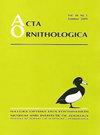阿根廷中西部普纳沙漠中一种选择性草食鸟类Puna Rhea taraparencis的觅食栖息地偏好
IF 1.3
4区 生物学
Q3 ORNITHOLOGY
引用次数: 0
摘要
摘要在食草动物中,栖息地偏好受到资源可用性的影响,这在沙漠生态系统中最为明显。沙漠puna是南美洲的一个环境,主要是长满草的草原,当地的草垫植物与潮湿的土壤条件有关,形成了被称为“vegas”的栖息地。在这种环境中,恒河猴对丰度低但次生化合物、纤维含量低或两者兼有的植物物种有强烈的选择性觅食策略。这与干旱环境中的其他多面手草食动物形成了鲜明对比,后者更喜欢纤维含量高、含量高的植物物种。我们确定了Rheas在三种栖息地类型中的栖息地使用:山麓、山谷和维加斯;并提供了它们觅食栖息地偏好的证据。从2011年到2014年,我们估计了鸟类的密度和环境变量,如植物总覆盖率和总食物、首选食物和非首选食物的丰度。特别是,密度是根据样带中鸟类粪便的计数和收集间接估计的。我们分析了栖息地类型和环境变量对鸟类密度的影响;并比较了不同生境的环境变量。Puna Rheas使用了这三个栖息地,但素食主义者的粪便记录非常稀少。山麓地区的密度高于山谷(分别为0.45和0.01 inds/km2),随着首选食物的丰度增加而增加,随着非首选食物的增加而下降。山麓是首选食物,因为它们的首选食物丰度最高,而非首选食物在山麓和山谷中也同样丰富。在Rheas食用的所有食物中,纯素食者的植物总覆盖率最高,丰度最低。因此,丰富的首选食物具有最佳的营养质量,这是对栖息地偏好的一个很好的预测,可能也是Puna Rhea生命周期中的一种重要资源。本文章由计算机程序翻译,如有差异,请以英文原文为准。
Foraging Habitat Preferences of a Selective Herbivorous Bird, the Puna Rhea Rhea tarapacencis in the Desert Puna, Midwestern Argentina
Abstract. In herbivores, habitat preference is influenced by resource availability, which is most evident in desert ecosystems. The desert puna is a South American environment dominated by grassy steppes with local grassy cushion plants associated with moist soil conditions, which form the habitat called ‘vegas'. In this environment, Puna Rhea Rhea tarapacencis has a strongly selective foraging strategy towards plant species that are in low abundance but that exhibit low contents of secondary compounds, fiber, or both. This contrasts with other generalist herbivores of arid environments, which prefer plant species with high fiber content and are highly abundant. We determined habitat use by Rheas in three habitat types: foothills, valley and vegas; and provided evidence of their feeding habitat preferences. From 2011 to 2014, we estimated density of birds and environmental variables such as total plant cover and abundance of total food, preferred foods and non-preferred foods. In particular, the density was estimated indirectly based on counting and collecting feces of the birds in transects. We analyzed the effect of the habitat type and environment variables on bird density; and compared the environmental variables among habitats. Puna Rheas used the three habitats, but fecal records were very scarce in vegas. The density was higher in foothills than in the valley (0.45 and 0.01 inds/km2, respectively), increased with higher abundance of the preferred foods and declined with increased non-preferred foods. The foothills were preferred as they had the highest abundance of the preferred foods and the non-preferred foods were similarly abundant in foothills and valley. The vegas had the highest total plant cover and the lowest abundance of all food species consumed by the Rheas. Therefore, the abundance of preferred foods, which have the best nutritional quality, represents a good predictor of habitat preference and, possibly, an essential resource during the life cycle of the Puna Rhea.
求助全文
通过发布文献求助,成功后即可免费获取论文全文。
去求助
来源期刊

Acta Ornithologica
生物-鸟类学
CiteScore
2.10
自引率
0.00%
发文量
14
审稿时长
>12 weeks
期刊介绍:
Publishes scientific papers (original research reports, reviews, short notes, etc.) and announcements from all fields of ornithology. All manuscripts are peer-reviewed.
Established in 1933 as Acta Ornithologica Musei Zoologici Polonici, since 1953 continued under the present title.
Published twice a year by the Natura Optima Dux Foundation under the auspices of the Museum and Institute of Zoology, Polish Academy of Sciences.
 求助内容:
求助内容: 应助结果提醒方式:
应助结果提醒方式:


